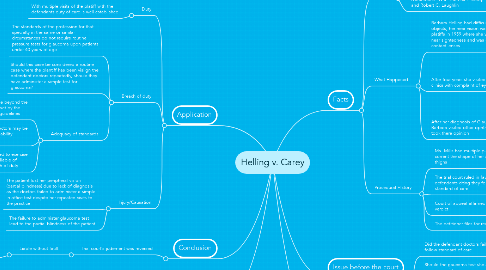
1. Application
1.1. Duty
1.1.1. With multiple visits of the platiff with the defendants duty of care is well established
1.2. Breach of duty
1.2.1. The standards of the profession for that specialty in the same or similar circumstances do not require routine pressure tests for glaucoma upon patients under 40 years of age
1.2.2. Should this case be considered a routine case where the plantiff has been visiign the defendant doctors repeatedly, shoule they have administer a simple test for glaucoma?
1.2.3. Adequacy of standards
1.2.3.1. The doctors could have gone beyond the minimum standards of care set by the professional body's clinical guidelines
1.2.3.2. In this case the defendants doctors may be found guilty of strict liability (liability without fault)
1.2.3.3. If the defendant doctors failed to exercise extra care, they can be held liable of negligence and hence breach of duty
1.3. Injury/Causation
1.3.1. The patient lost her peripheral vision (partial blindness) due to lack of diagnosis as the doctors failed to administer a simple in office test despite her repeated visits to the practice
1.3.2. The failure to administer glaucoma test lead to the partial blindness of the patient
2. Facts
2.1. Parties
2.1.1. Plaintiffs - Morrison P. Helling and Barbara Helling (husband and wife)
2.1.1.1. Barbara Helling is a 32 years old eye patient and Morrison her husband
2.1.2. Defendetns - Drs. Thomas F. Carey and Robert C. Laughlin
2.1.2.1. Both are eye doctors and work in a partnership at a private ophthalmology clinic
2.2. What Happened
2.2.1. Barbara Helling had difficulty seeing distant objects, her near vision was fine. She saw the platiffs in 1959 where she was diagnosed for near sightedness and was given corrective contact lenses
2.2.2. After four years she visited the defendants clinics with complaint of eye irritation
2.2.2.1. She visited the practice multiple times witht the same complaint, however no investigation or examination was done by the doctors
2.2.2.2. It was in 1968 when she complained of loss of some peripheral visions. During this visit she was diagnosed of Glaucoma
2.2.3. After her diagnosis of Glaucoma in 1969, Barbara visited other ophthalmologists and took there opinion
2.2.3.1. She filed lawsuite against the practice doctors claiming that the doctors failed to diagnose her condition that led to loss of her peripheral vision
2.3. Procedural History
2.3.1. Ms. Mills had multiple plastic surgeries to corrent the shape of her abdomen and thighs
2.3.2. The trial court ruled in favor of the defendants citing they followed standard of care
2.3.3. Court of appeal affirmed the trial courts verdict
2.3.4. The petitioner files for review appeal
3. Conclusion
3.1. Trial court's judement was reversed
3.1.1. Liable without fault
3.1.1.1. The court ruled in favor of the plantiff sighting the defendants to be strictly liable
4. Issue before the court
4.1. Did the defendant doctors failed to follow standard of care
4.1.1. Comliance negligence
4.2. Should the gaucoma test should has been administered earlier as patient was using contact lenses
4.3. Are glaucoma testing procedures sufficient?
5. Rule of Law
5.1. Negligence of care
5.1.1. Duty, breach of duty, and inujy/causation
5.1.1.1. Plaintiff has to proof that the defendants failed to give her proper eye care by not doing glaucoma test in time
5.1.1.2. Defense is simple as the doctors acted within the professional guidelines of eye care
